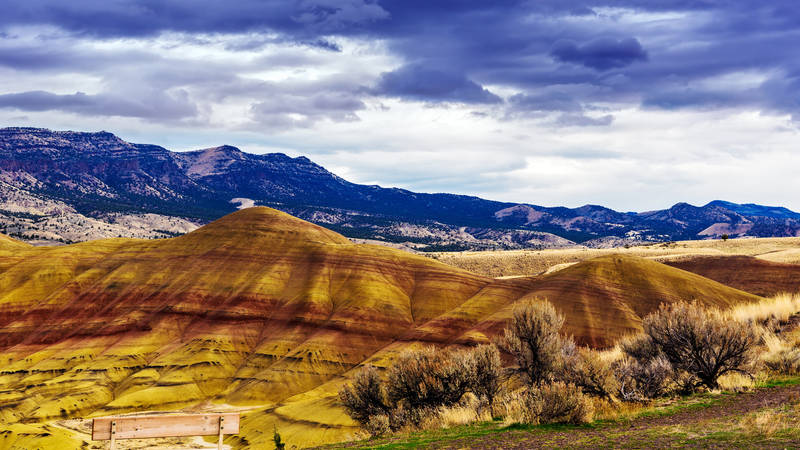Winter 2017
A Rare Tuft
Can grass nerds save an extremely rare grass that lives high in the mountains of Big Bend National Park?
The Guadalupe fescue is an unlikely celebrity in the plant world. A slim, knee-high bunchgrass with delicate pale yellow blooms, it looks like other grasses that grow in the high peaks of the Chihuahuan Desert. But though its appearance is unremarkable, the Guadalupe fescue is different. It is among the rarest plants in the world and a prized find for botanists. In the U.S., it sprouts in only one location: a cool forested enclave along the popular Boot Canyon Trail high in the Chisos Mountains of Texas’ Big Bend National Park.
DOOMED BY ITS BLOOMS?
“If you have walked up Boot Canyon, you have walked right by it — probably within 6 inches of it,” said Joe Sirotnak, who was until recently a botanist at Big Bend. “Only grass nerds really even know to look for it, but this plant has fans, you know, it has admirers who come up here.”
One sunny, cold October day, some of those fans — more precisely, a team of National Park Service rangers — hiked up the Boot Canyon Trail, past stands of Douglas fir, aspen groves and rocky pinnacles with views over the pale desert far below. Finally, they arrived in a pine-oak woodland that sits more than 6,000 feet above sea level and is 5 miles from the nearest road. Armed with tags and wires to mark any new tufts of the rare grass, a compass to locate known plants, a tape measure and knee pads, they got down on all fours and crawled about, looking for the fescue among the rocks and trees.
After about eight hours of scrambling, the researchers had scoured all six research plots — 33-foot-diameter areas that have been monitored annually since 1993 — and come up with a grand total of 56 tufts of Guadalupe fescue. The count confirmed a long-term trend: This fragile, defenseless plant is in trouble.
It’s so close to extinction that in September, the U.S. Fish and Wildlife Service proposed listing it as endangered, a move that will likely be confirmed in 2017. Including areas beyond the monitoring plots, Sirotnak estimates fewer than 200 individual plants survive here. There is only one other confirmed location where the rare bunchgrass dwells: a protected area, Maderas del Carmen, in Mexico, about 20 miles east of Big Bend. The fescue was known to exist in two other sites in northern Mexico, but botanists haven’t been there in decades.
Because it is so obscure and difficult to find, little is known about the Guadalupe fescue. Botanists believe it could be a relic of the last ice age when the climate was much cooler than it is today. As the climate warmed, the grass might have died in low-lying areas and reseeded in higher, cooler areas, eventually ending up only in so-called sky islands, high isolated mountain ranges moated by desert, which often harbor rare endemic species.
Botanists first discovered the Guadalupe fescue in 1931 in lush McKittrick Canyon in the Guadalupe Mountains of West Texas, an area that became a national park 41 years later. Despite at least a dozen field trips and plenty of crawling around in the dirt, no one has been able to find the plant there since 1952. Officially, botanists accept that the grass was extirpated from the area, though a few lonely tufts might still poke up somewhere far beyond human traffic.
“We hope that it has been overlooked,” said Chris Best, Texas state botanist for the Fish and Wildlife Service. “That could mean that there would be more of it out there, and it might not be so close to extinction.”
The plant faces numerous threats, including trail runoff that can damage habitat and a fungus that infects the seeds. Livestock grazing also threatens the grass in Mexico. As climate change brings higher temperatures and changing rainfall, the cool, moist habitat the fescue favors will likely continue to shrink. And the big wild card is fire. Scientists suspect that the fescue adapted to low-intensity fires, but for decades land-management agencies aggressively put out all fires, leading to overgrowth of the understory. Now, the abundance of quick-burning vegetation facilitates the kind of high-intensity fires that could devastate the fescue in Big Bend, where it ranges over an area scarcely bigger than 12 acres, Sirotnak said.
The fescue also has biological challenges. It’s pollinated by wind rather than animals, which means that individuals need to be close to each other and make pollen at the same time to reproduce. This particular plant doesn’t make an abundance of pollen, and with such a small population, it is probably highly inbred. No one knows exactly how the Guadalupe fescue responds to inbreeding, but some inbred plants become weaker, less fit for their habitats and less successful in reproducing.
Listing the species as endangered is unlikely to change how it’s managed in the short term. Luckily, it’s already under the protection of the Park Service, which has managed the plant under an agreement with the Fish and Wildlife Service since 1998. But its endangered status could help attract funding to study this little-known plant and its sky-island ecosystem. And a better understanding of those habitats could help conserve other sensitive flora.

National Parks
You can read this and other stories about history, nature, culture, art, conservation, travel, science and more in National Parks magazine. Your tax-deductible membership donation of $25 or more entitles…
See more ›The Fish and Wildlife Service would also like to send researchers to count the whole population, including areas beyond the monitoring plots. After further study, the Park Service might consider running microscale burns to improve habitat conditions or collaborate with Mexican land managers to cross-pollinate populations and improve genetic diversity.
Some might ask: Why put so much effort into saving an uncharismatic plant that resembles an overgrown tuft of Kentucky bluegrass?
“The easy answer is the law says we have to protect it,” Best said. “Another answer would be, well, as the dominant species on our planet, we have a responsibility to protect other entities, meaning the plants and animals that we share our planet with.” And for grass lovers, that means even the littlest tufts of an obscure wiry plant in the high mountains of the desert Southwest.
About the author
-
 Kate Siber
Kate SiberKate Siber, a freelance writer and correspondent for Outside magazine, is based in Durango, Colorado. Her writing has appeared in National Geographic Traveler and The New York Times. She is also the author of “National Parks of the U.S.A.,” a best-selling children’s book.



